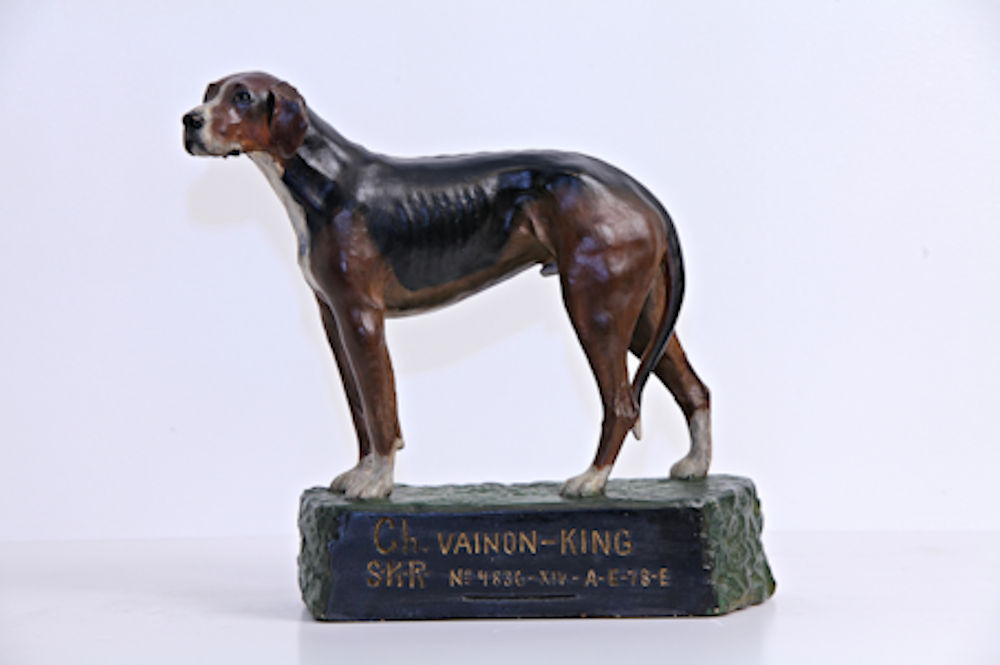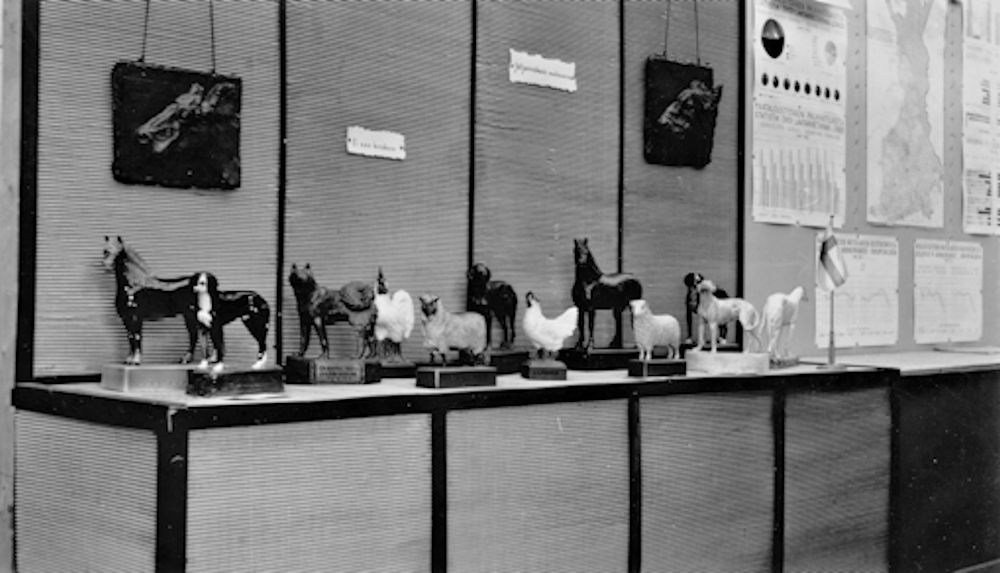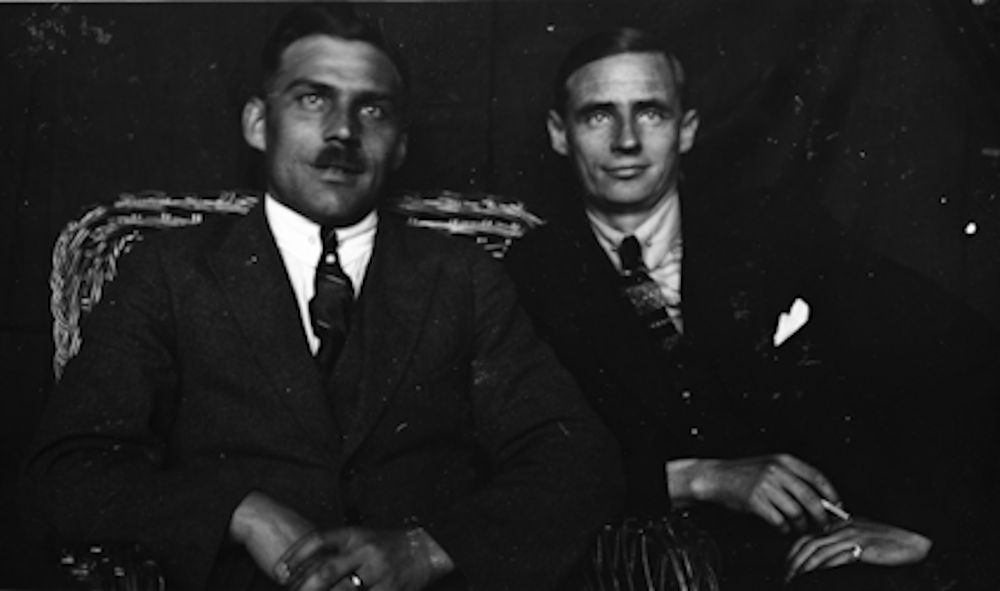When I visited the University of Helsinki’s Agricultural Museum with my colleagues in the winter of 2012, I fell in love with its extensive collection of animal sculptures which was on display in a side room on the first floor. The curator of the Agricultural Museum was about to retire and the museum had just been transferred under the Helsinki University Museum. The figurines of domestic animals, made by Anton Ravander-Rauas (1890–1972, Ravander until 1936) were grouped by species on the shelves, while reliefs hung on display on the walls. There were cows, bulls, horses, pigs, dogs, and sheep, just to mention a few. When we later on were selecting the Helsinki University Museum’s last exhibition to be mounted in the Arppeanum building, I suggested the collection of animal sculptures. The charming figurines, portraying Finnish animal personalities, had been hidden away from the public for many years.

When I studied the sculptures closer, I took a special liking to the statuette depicting a Finnish Hound called Vainon King. The artist has vividly captured the male dog’s gentle and understanding look, as if he has come to life again. The sculpture portrays a dog that the artist presents in its natural colour and in a pose that he in all likelihood has taken in dog shows. The sculpture is a painted plaster cast of a height of 35 centimetres and a width of 42 centimetres. The side of the sculpture’s green base, imitating grass, features a carving of the dog’s name, registration date and the owner’s name. The artist’s signature can be found on the shorter side of the base.

Dog called Vainon King
A puppy named Vainon King was born on 6 March 1927 in Helsinki, into the home of Heikki Lampinen, a breeder of Finnish Hounds. Lampinen had established a kennel under the name of Vainon, and registered it under the Finnish Kennel Club in 1923. The founding dam was called Vaino (1918–1929), whose many puppies became winners of championship titles. The sire of the litter born in March 1927 was a Finnish Hound called Klang av Furuborg. Uno Lindquist from the town of Porvoo bought the puppy Vainon King and started training him, took him hunting as well as to dog shows.
In the 22nd show of the Finnish Kennel Club in May 1929, Vainon King was awarded as the best of breed in the class of Finnish Hounds. The judge at the show, Ivar Ekberg, found him to be a large, impressive and well-built hound. It’s chest depth and croup were first class and the head was well formed. The judge did criticise, however, the light bone structure of his legs as well as the shortness and softness of his coat. In this show, there were 51 Finnish Hounds in the open class, and nine received a first class prize. The nine holders of first-class prizes were judged once again, and Vainon King was declared the overall winner. The judge for the first class praised King to be flawlessly built and in good condition. A further merit was that the dog knew how to pose calmly and gracefully in front of the judge. This winner’s life became quite eventful: in 1929 he mated at least two bitches and the following year, he posed for an artist. No information about his later years has survived to date. King had a sister from the same litter called Vainon Kaiho, a winner of a championship title as well, who was also immortalised into a sculpture by Ravander-Rauas.

Vainon King was entered into the special breed registry of Finnish Hounds in 1929. He served as an example when the breed standard of the Finnish Hound was finalised in 1932. The drafting committee was convened in Hotel Kämp, where Ravander-Rauas took his statuette to remind them of Vainon King’s appearance. The committee decided to have the sculpture cast in bronze also, but the Helsinki University Museum has no knowledge of whether this plan was ever realised. In the early 1930s, the Arabia ceramics factory made an experiment with a porcelain version of the plaster cast of Vainon King. This experiment did not lead to mass production, but a porcelain version of Vainon King has been preserved and is now part of the collections of the Design Museum. Liisa Raunio from Helsinki sent Anton Ravander-Raunio a Finnish-language poem praising Vainon King as follows: Vainon-King ̶ tuo uljas ajokoira / on mieliin jäänyt monin tavoin. / Sen tyypissä on rodun jalous ja käyttövoima / Sen luonteen rehtiys niin avoin ̶ ̶ . (Vainon King, that magnificent hound / is remembered for many a cause. / He represents the breed’s nobility and strength / His frank character is without flaws.)

Anton Ravander-Rauas and dogs
Anton Ravander-Rauas was a self-taught sculptor who began his career by making sculptures of Finnish Hounds. He himself had a Finnish Spitz called Repo and a Finnish Hound called Kaija that he used for rabbit hunting in the first decade of the 20th century. In 1914 he acquired a black hound called Nurmes Konna. Ravander-Rauas had an acquaintance, the sculptor August Koskinen (1887–1936), who specialised in animal motifs. Koskinen made sculptures of both wild and domestic animals, as well as of pets. His bronze patinated plaster cast of Vainon Ansa, a female Finnish Hound, has been in the collections of the Finnish Kennel Club since 1963.
In 1927 Ravander-Rauas and Koskinen staged a playful competition on which of them knows dogs better. Both would make a dog sculpture out of clay, and a prestigious jury would select the winner. Ravander-Rauas used the Finnish Hound of Vilho Häggqvist, his brother-in-law, as the model for his sculpture. As it turned out, Ravander-Rauas won the competition. He then started making dog sculptures, and dogs remained in his repertoire throughout his career. His last work from 1970, a statuette painted in natural colours, depicted a Finnish Hound called Lini. The University Museum’s collection includes a version of most of the dog sculptures made by Ravander-Rauas.

Events in the history of the Vainon King sculpture
The sculpture depicting the Finnish Hound Vainon King was donated, along with other animal sculptures made by Ravander-Rauas, to the Agricultural Museum of the University of Helsinki in 1971. The sculptures were on display in the museum’s prime spot for some years, before they were transferred to a back room on the first floor.
When Vainon King was selected for the Helsinki University Museum’s Prime Specimens exhibition in the winter of 2014, Conservator Lasse Lehtinen cleaned it using a cotton bud and amylase. The colours of the statuette brightened up and the surface became shiny. Once the exhibition closed, the animal sculptures were transferred to the new collections facility of the Helsinki University Museum. Since the autumn of 2017, Vainon King has been on display on the Viikki Campus, in the downstairs lobby of Latokartanonkaari 7, along with many other sculptures by Ravander-Rauas. A richly illustrated book on Anton Ravander-Rauas and his animal sculptures is available for purchase at the info desk of the Power of Thought exhibition of the Helsinki University Museum until the end of 2020.
Pia Vuorikoski, Head of Exhibitions
Translation: University of Helsinki Language Services.
Sources:
Eläintenveistäjä. Anton Ravander-Rauas ja Suomen eläinveistotaiteen huiput (ed. Pia Vuorikoski).
Finska kennelklubbens tidskrift 3-4/1929, 6/1923
Suomen Kennelklubin aikakauskirja 6/1929, 3-4/1929
https://www.koiramuseo.fi/en/item/ajokoira-vainon-ansa?from=/en/search/items
